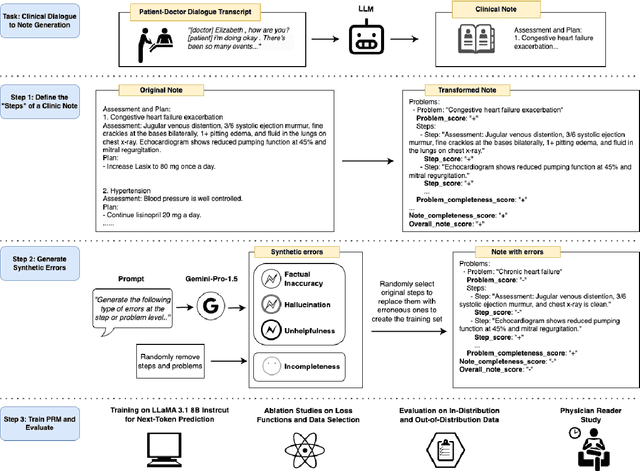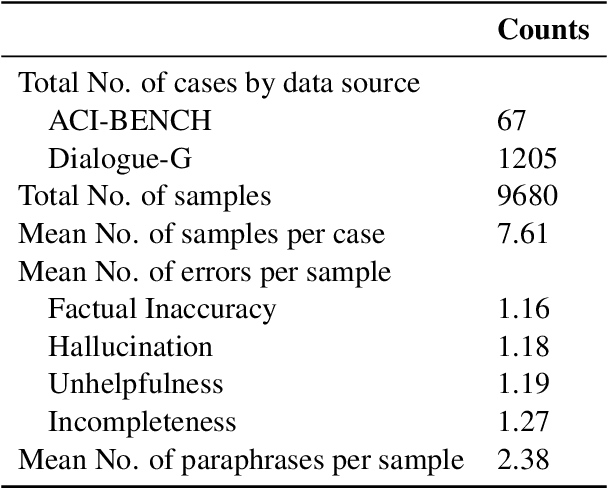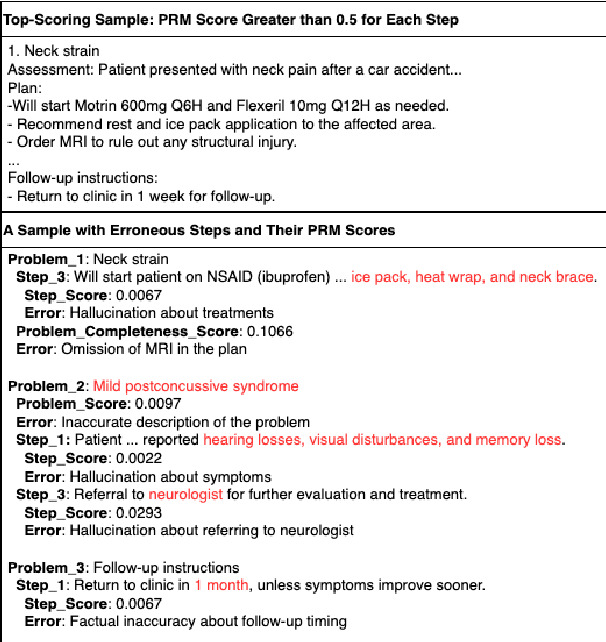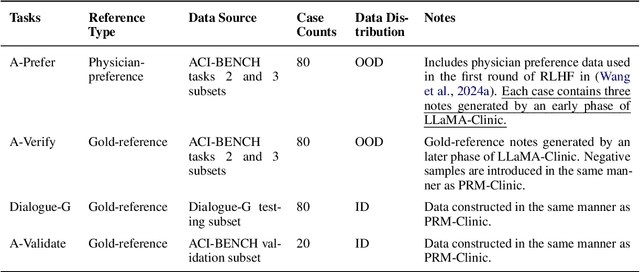Jimeng Sun
InformGen: An AI Copilot for Accurate and Compliant Clinical Research Consent Document Generation
Apr 01, 2025Abstract:Leveraging large language models (LLMs) to generate high-stakes documents, such as informed consent forms (ICFs), remains a significant challenge due to the extreme need for regulatory compliance and factual accuracy. Here, we present InformGen, an LLM-driven copilot for accurate and compliant ICF drafting by optimized knowledge document parsing and content generation, with humans in the loop. We further construct a benchmark dataset comprising protocols and ICFs from 900 clinical trials. Experimental results demonstrate that InformGen achieves near 100% compliance with 18 core regulatory rules derived from FDA guidelines, outperforming a vanilla GPT-4o model by up to 30%. Additionally, a user study with five annotators shows that InformGen, when integrated with manual intervention, attains over 90% factual accuracy, significantly surpassing the vanilla GPT-4o model's 57%-82%. Crucially, InformGen ensures traceability by providing inline citations to source protocols, enabling easy verification and maintaining the highest standards of factual integrity.
ExPath: Towards Explaining Targeted Pathways for Biological Knowledge Bases
Feb 25, 2025Abstract:Biological knowledge bases provide systemically functional pathways of cells or organisms in terms of molecular interaction. However, recognizing more targeted pathways, particularly when incorporating wet-lab experimental data, remains challenging and typically requires downstream biological analyses and expertise. In this paper, we frame this challenge as a solvable graph learning and explaining task and propose a novel pathway inference framework, ExPath, that explicitly integrates experimental data, specifically amino acid sequences (AA-seqs), to classify various graphs (bio-networks) in biological databases. The links (representing pathways) that contribute more to classification can be considered as targeted pathways. Technically, ExPath comprises three components: (1) a large protein language model (pLM) that encodes and embeds AA-seqs into graph, overcoming traditional obstacles in processing AA-seq data, such as BLAST; (2) PathMamba, a hybrid architecture combining graph neural networks (GNNs) with state-space sequence modeling (Mamba) to capture both local interactions and global pathway-level dependencies; and (3) PathExplainer, a subgraph learning module that identifies functionally critical nodes and edges through trainable pathway masks. We also propose ML-oriented biological evaluations and a new metric. The experiments involving 301 bio-networks evaluations demonstrate that pathways inferred by ExPath maintain biological meaningfulness. We will publicly release curated 301 bio-network data soon.
Single-Channel EEG Tokenization Through Time-Frequency Modeling
Feb 22, 2025Abstract:We introduce TFM-Tokenizer, a novel tokenization framework tailored for EEG analysis that transforms continuous, noisy brain signals into a sequence of discrete, well-represented tokens for various EEG tasks. Conventional approaches typically rely on continuous embeddings and inter-channel dependencies, which are limited in capturing inherent EEG features such as temporally unpredictable patterns and diverse oscillatory waveforms. In contrast, we hypothesize that critical time-frequency features can be effectively captured from a single channel. By learning tokens that encapsulate these intrinsic patterns within a single channel, our approach yields a scalable tokenizer adaptable across diverse EEG settings. We integrate the TFM-Tokenizer with a transformer-based TFM-Encoder, leveraging established pretraining techniques from natural language processing, such as masked token prediction, followed by downstream fine-tuning for various EEG tasks. Experiments across four EEG datasets show that TFM-Token outperforms state-of-the-art methods. On TUEV, our approach improves balanced accuracy and Cohen's Kappa by 5% over baselines. Comprehensive analysis of the learned tokens demonstrates their ability to capture class-distinctive features, enhance frequency representation, and ability to encode time-frequency motifs into distinct tokens, improving interpretability.
Generation of Drug-Induced Cardiac Reactions towards Virtual Clinical Trials
Feb 11, 2025Abstract:Clinical trials are pivotal in cardiac drug development, yet they often fail due to inadequate efficacy and unexpected safety issues, leading to significant financial losses. Using in-silico trials to replace a part of physical clinical trials, e.g., leveraging advanced generative models to generate drug-influenced electrocardiograms (ECGs), seems an effective method to reduce financial risk and potential harm to trial participants. While existing generative models have demonstrated progress in ECG generation, they fall short in modeling drug reactions due to limited fidelity and inability to capture individualized drug response patterns. In this paper, we propose a Drug-Aware Diffusion Model (DADM), which could simulate individualized drug reactions while ensuring fidelity. To ensure fidelity, we construct a set of ordinary differential equations to provide external physical knowledge (EPK) of the realistic ECG morphology. The EPK is used to adaptively constrain the morphology of the generated ECGs through a dynamic cross-attention (DCA) mechanism. Furthermore, we propose an extension of ControlNet to incorporate demographic and drug data, simulating individual drug reactions. We compare DADM with the other eight state-of-the-art ECG generative models on two real-world databases covering 8 types of drug regimens. The results demonstrate that DADM can more accurately simulate drug-induced changes in ECGs, improving the accuracy by at least 5.79% and recall by 8%.
Towards Physiologically Sensible Predictions via the Rule-based Reinforcement Learning Layer
Jan 31, 2025Abstract:This paper adds to the growing literature of reinforcement learning (RL) for healthcare by proposing a novel paradigm: augmenting any predictor with Rule-based RL Layer (RRLL) that corrects the model's physiologically impossible predictions. Specifically, RRLL takes as input states predicted labels and outputs corrected labels as actions. The reward of the state-action pair is evaluated by a set of general rules. RRLL is efficient, general and lightweight: it does not require heavy expert knowledge like prior work but only a set of impossible transitions. This set is much smaller than all possible transitions; yet it can effectively reduce physiologically impossible mistakes made by the state-of-the-art predictor models. We verify the utility of RRLL on a variety of important healthcare classification problems and observe significant improvements using the same setup, with only the domain-specific set of impossibility changed. In-depth analysis shows that RRLL indeed improves accuracy by effectively reducing the presence of physiologically impossible predictions.
A foundation model for human-AI collaboration in medical literature mining
Jan 27, 2025



Abstract:Systematic literature review is essential for evidence-based medicine, requiring comprehensive analysis of clinical trial publications. However, the application of artificial intelligence (AI) models for medical literature mining has been limited by insufficient training and evaluation across broad therapeutic areas and diverse tasks. Here, we present LEADS, an AI foundation model for study search, screening, and data extraction from medical literature. The model is trained on 633,759 instruction data points in LEADSInstruct, curated from 21,335 systematic reviews, 453,625 clinical trial publications, and 27,015 clinical trial registries. We showed that LEADS demonstrates consistent improvements over four cutting-edge generic large language models (LLMs) on six tasks. Furthermore, LEADS enhances expert workflows by providing supportive references following expert requests, streamlining processes while maintaining high-quality results. A study with 16 clinicians and medical researchers from 14 different institutions revealed that experts collaborating with LEADS achieved a recall of 0.81 compared to 0.77 experts working alone in study selection, with a time savings of 22.6%. In data extraction tasks, experts using LEADS achieved an accuracy of 0.85 versus 0.80 without using LEADS, alongside a 26.9% time savings. These findings highlight the potential of specialized medical literature foundation models to outperform generic models, delivering significant quality and efficiency benefits when integrated into expert workflows for medical literature mining.
SODor: Long-Term EEG Partitioning for Seizure Onset Detection
Dec 20, 2024



Abstract:Deep learning models have recently shown great success in classifying epileptic patients using EEG recordings. Unfortunately, classification-based methods lack a sound mechanism to detect the onset of seizure events. In this work, we propose a two-stage framework, \method, that explicitly models seizure onset through a novel task formulation of subsequence clustering. Given an EEG sequence, the framework first learns a set of second-level embeddings with label supervision. It then employs model-based clustering to explicitly capture long-term temporal dependencies in EEG sequences and identify meaningful subsequences. Epochs within a subsequence share a common cluster assignment (normal or seizure), with cluster or state transitions representing successful onset detections. Extensive experiments on three datasets demonstrate that our method can correct misclassifications, achieving 5%-11% classification improvements over other baselines and accurately detecting seizure onsets.
Process-Supervised Reward Models for Clinical Note Generation: A Scalable Approach Guided by Domain Expertise
Dec 17, 2024



Abstract:Process-supervised reward models (PRMs), which verify large language model (LLM) outputs step-by-step, have achieved significant success in mathematical and coding problems. However, their application to other domains remains largely unexplored. In this work, we train a PRM to provide step-level reward signals for clinical notes generated by LLMs from patient-doctor dialogues. Guided by real-world clinician expertise, we carefully designed step definitions for clinical notes and utilized Gemini-Pro 1.5 to automatically generate process supervision data at scale. Our proposed PRM, trained on the LLaMA-3.1 8B instruct model, demonstrated superior performance compared to Gemini-Pro 1.5 and an outcome-supervised reward model (ORM) across two key evaluations: (1) the accuracy of selecting gold-reference samples from error-containing samples, achieving 98.8% (versus 61.3% for ORM and 93.8% for Gemini-Pro 1.5), and (2) the accuracy of selecting physician-preferred notes, achieving 56.2% (compared to 51.2% for ORM and 50.0% for Gemini-Pro 1.5). Additionally, we conducted ablation studies to determine optimal loss functions and data selection strategies, along with physician reader studies to explore predictors of downstream Best-of-N performance. Our promising results suggest the potential of PRMs to extend beyond the clinical domain, offering a scalable and effective solution for diverse generative tasks.
Medical Video Generation for Disease Progression Simulation
Nov 18, 2024Abstract:Modeling disease progression is crucial for improving the quality and efficacy of clinical diagnosis and prognosis, but it is often hindered by a lack of longitudinal medical image monitoring for individual patients. To address this challenge, we propose the first Medical Video Generation (MVG) framework that enables controlled manipulation of disease-related image and video features, allowing precise, realistic, and personalized simulations of disease progression. Our approach begins by leveraging large language models (LLMs) to recaption prompt for disease trajectory. Next, a controllable multi-round diffusion model simulates the disease progression state for each patient, creating realistic intermediate disease state sequence. Finally, a diffusion-based video transition generation model interpolates disease progression between these states. We validate our framework across three medical imaging domains: chest X-ray, fundus photography, and skin image. Our results demonstrate that MVG significantly outperforms baseline models in generating coherent and clinically plausible disease trajectories. Two user studies by veteran physicians, provide further validation and insights into the clinical utility of the generated sequences. MVG has the potential to assist healthcare providers in modeling disease trajectories, interpolating missing medical image data, and enhancing medical education through realistic, dynamic visualizations of disease progression.
AnyECG: Foundational Models for Electrocardiogram Analysis
Nov 17, 2024



Abstract:Electrocardiogram (ECG), a non-invasive and affordable tool for cardiac monitoring, is highly sensitive in detecting acute heart attacks. However, due to the lengthy nature of ECG recordings, numerous machine learning methods have been developed for automated heart disease detection to reduce human workload. Despite these efforts, performance remains suboptimal. A key obstacle is the inherent complexity of ECG data, which includes heterogeneity (e.g., varying sampling rates), high levels of noise, demographic-related pattern shifts, and intricate rhythm-event associations. To overcome these challenges, this paper introduces AnyECG, a foundational model designed to extract robust representations from any real-world ECG data. Specifically, a tailored ECG Tokenizer encodes each fixed-duration ECG fragment into a token and, guided by proxy tasks, converts noisy, continuous ECG features into discrete, compact, and clinically meaningful local rhythm codes. These codes encapsulate basic morphological, frequency, and demographic information (e.g., sex), effectively mitigating signal noise. We further pre-train the AnyECG to learn rhythmic pattern associations across ECG tokens, enabling the capture of cardiac event semantics. By being jointly pre-trained on diverse ECG data sources, AnyECG is capable of generalizing across a wide range of downstream tasks where ECG signals are recorded from various devices and scenarios. Experimental results in anomaly detection, arrhythmia detection, corrupted lead generation, and ultra-long ECG signal analysis demonstrate that AnyECG learns common ECG knowledge from data and significantly outperforms cutting-edge methods in each respective task.
 Add to Chrome
Add to Chrome Add to Firefox
Add to Firefox Add to Edge
Add to Edge